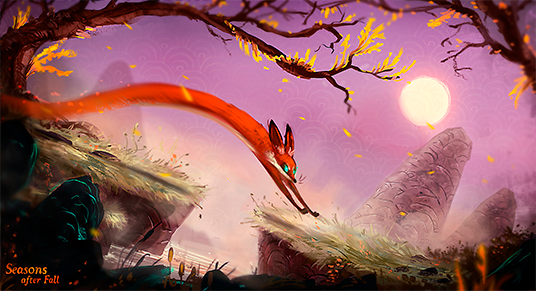Do you ever wish you had the power to change the seasons instantly? What about possessing the body of a fox? Even if you’ve never had either of those two (admittedly quite niche) power fantasies, Seasons After Fall might be up your alley.
A beautiful Metroidvania style platform game, Seasons After Fall features sublime, hand-drawn artwork by French illustrator Géraud Soulié that looks like it came straight out of a high-end children’s picture book, with broad painterly brushstrokes giving the feeling of being in an Impressionist landscape. There are very distinct styles for each season; Winter is cold and hard, with frozen lakes and snow-covered trees, Spring is full of verdant greens and April showers. The fox is incredibly cute (particularly when scrabbling up the side of a platform) and the sound design (featuring a lot of strings) is appropriately whimsical and melodic, helping to really increase the feeling of atmosphere in the forest itself.
The gameplay experience is relaxing and soothing, and fluidly bounding across the forest platforms feels very liberating. The unfolding of the narrative can seem to drag a little at times, particularly in the early stages. You can’t die in this game, and the pace is quite measured, with some elements feeling somewhat repetitive; when you finish a level you then have to manually gambol all the way back to the Sanctuary (the main hub).
The narrative divides into two parts; initially, you need to collect the individual powers of the seasons from the Guardians that inhabit different parts of the forest. Once you have these seasonal essences at your disposal (different seasons open different parts of the map), you then re-visit previous areas to get to those parts that were previously inaccessible and release the four winds. For example, Autumn opens up mushrooms that act as platforms, Winter freezes columns of water into climbable ice towers, Spring increases the water flow, making even higher platforms and Summer causes the water level to drop in the lakes. Switching between the seasons is smooth and easy to achieve, and for some puzzles, you will need to perform several changes in sequence. There are also some slightly more complex puzzles where you have to use fireflies in varying ways, which were quite delightful.

Whilst none of the puzzles are particularly challenging, there are some areas of the game that are frustratingly lacking in guidance. As you are essentially revisiting parts of the forest several times (without the aid of a map I might add), occasionally you are given no clue which direction you are supposed to be heading, meaning that you sometimes have to go back to every single area and work it out via a process of elimination. The landscapes can be really quite similar and as a consequence, it is surprisingly easy to get lost or to misremember where you saw a point of interest. This seems both frustrating and unnecessary – one simple prompt, well-timed (which you get at some points, but not others) or indeed, the provision of a map, would make reaching the next stage of the narrative far clearer.
Overall the game is really charming, and appropriate for all ages due to its lack of violence (there are no Animals of Farthing Wood moments to permanently scar children) and the game has a subtle underlying message of appreciation of outside spaces and respect for living things (but not in an overt or preachy manner). Whilst not enormously original in terms of gameplay mechanics (the season changing is well thought out, but underneath the pretty exterior it is a fairly standard platformer), it is a bucolic green and pleasant land that is worthy of exploration.

